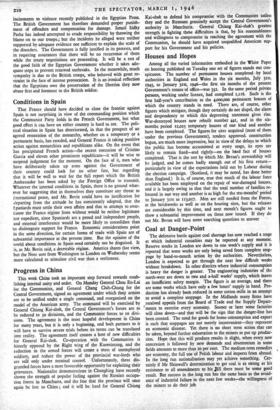Houses and Hopes
Among all the varied information embodied in the White Paper on housing published on Tuesday one set of figures stands out con- spicuous. The number of permanent houses completed - by local authorities in England and Wales in the six months, July 31st, 1945, to January 31st, 1946—the first six months of the present Government's tenure of office—was 352. In the same period private persons, working under licence, had completed 1,116. Such is the first half-year's contribution to the 4,000,000 permanent houses of which the country stands in need. There are, of course, other figures which mitigate, though they certainly do not dispel, the alarm and despondency to which this depressing statement gives rise. War-destroyed houses now rebuilt number 441, and in the six- months period 12,025 temporary houses of one kind and another have been completed. The figures for sites acquired (most of them under the previous Government), tenders approved, construction begun, are much more impressive, but in view of the delays to which the public has become accustomed at every stage, its eyes are likely to remain fixed—and rightly—on the hard fact of houses completed. That is the test by Which Mr. Bevan's stewardship will be judged, and he comes badly enough out of his first return— particularly in view of the expectations held out by Labour during the election campaign. (Scotland, it may be noted, has done better than England.) It is, of course, true that much of the labour force available has been employed on the repair of war-damaged houses, and it is largely owing to that that the total number of families re- housed in one way and another is as high for the ten-months' period to January 31st as 113,057. Men are still needed from the Forces, at the brickworks as well as on the housing sites, but the releases are considerable by this time, and next month's figures ought to show a substantial improvement on those now issued. If they do not Mr. Bevan will have some searching questions to answer


























 Previous page
Previous page